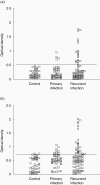Mucosal and peripheral immune responses to chlamydial heat shock proteins in women infected with Chlamydia trachomatis
- PMID: 17493018
- PMCID: PMC1941927
- DOI: 10.1111/j.1365-2249.2007.03357.x
Mucosal and peripheral immune responses to chlamydial heat shock proteins in women infected with Chlamydia trachomatis
Abstract
Most of the studies on 60-kDa and 10-kDa chlamydial heat shock proteins (HSPs) to date have been carried out with blood lymphocytes or serum antibody responses, which do not provide a clear picture of the actual pathogenesis as they do not differentiate primary infection from recurrent infection. Thus, in the present study induction of the immune response was evaluated by studying lymphoproliferation of both cervical and peripheral lymphocytes to synthetic peptides of cHSP60, cHSP10 and major outer membrane protein (MOMP) antigen. In addition, cervical antibody prevalence to MOMP antigen, cHSP60 and cHSP10 and cytokine levels in cervical washes was also determined. Positive proliferative responses of cervical lymphocytes to cHSP10 peptide were significantly higher (P < 0.05) in women with recurrent infections and that to MOMP antigen were significantly higher in primary infection. On proliferation of PBMCs with the above antigens, no significant difference was observed between primary and recurrent infection. Prevalence of cervical IgG and IgA antibodies to Chlamydia trachomatis was significantly higher (P < 0.05) during primary infection than recurrent infections. In contrast, prevalence of IgG and IgA antibodies to cHSP10 and IgG antibodies to cHSP60 was higher during recurrent infections than primary infections. Interferon (IFN)-gamma levels were significantly higher in cervical washes of women with recurrent infection and correlated strongly with cHSP60 antibody titres. Our data thus suggest that mucosal responses are more appropriate in understanding the pathogenesis of chlamydial infection and IFN-gamma could be involved in the modulation of immune responses towards chlamydial infection directly, by causing acute inflammation, or indirectly through modulation of HSP expression.
Figures


Similar articles
-
In infertile women, cells from Chlamydia trachomatis infected sites release higher levels of interferon-gamma, interleukin-10 and tumor necrosis factor-alpha upon heat-shock-protein stimulation than fertile women.Reprod Biol Endocrinol. 2008 May 20;6:20. doi: 10.1186/1477-7827-6-20. Reprod Biol Endocrinol. 2008. PMID: 18489796 Free PMC article.
-
Primary and secondary immune responses of mucosal and peripheral lymphocytes during Chlamydia trachomatis infection.FEMS Immunol Med Microbiol. 2007 Mar;49(2):280-7. doi: 10.1111/j.1574-695X.2006.00196.x. FEMS Immunol Med Microbiol. 2007. PMID: 17328762
-
Chlamydia trachomatis-specific heat shock proteins 60 antibodies can serve as prognostic marker in secondary infertile women.Infection. 2008 Aug;36(4):374-8. doi: 10.1007/s15010-008-7129-9. Epub 2008 Jul 19. Infection. 2008. PMID: 18642113
-
Chlamydial hsp60 and the immunopathogenesis of chlamydial disease.Semin Immunol. 1991 Jan;3(1):25-33. Semin Immunol. 1991. PMID: 1680011 Review.
-
Chlamydia trachomatis antigens: role in immunity and pathogenesis.Infect Agents Dis. 1994 Oct;3(5):218-33. Infect Agents Dis. 1994. PMID: 7866655 Review.
Cited by
-
Human and Pathogen Factors Associated with Chlamydia trachomatis-Related Infertility in Women.Clin Microbiol Rev. 2015 Oct;28(4):969-85. doi: 10.1128/CMR.00035-15. Clin Microbiol Rev. 2015. PMID: 26310245 Free PMC article. Review.
-
Host immune responses to chlamydial inclusion membrane proteins B and C in Chlamydia trachomatis infected women with or without fertility disorders.Reprod Biol Endocrinol. 2009 Apr 28;7:38. doi: 10.1186/1477-7827-7-38. Reprod Biol Endocrinol. 2009. PMID: 19397832 Free PMC article.
-
Immunopathogenesis in Chlamydia trachomatis Infected Women.ISRN Obstet Gynecol. 2011;2011:436936. doi: 10.5402/2011/436936. Epub 2011 Nov 24. ISRN Obstet Gynecol. 2011. PMID: 22191045 Free PMC article.
-
Chlamydia trachomatis Antibody Testing in Vaginal Mucosal Material versus Blood Samples of Women Attending a Fertility Clinic and an STI Clinic.Obstet Gynecol Int. 2014;2014:601932. doi: 10.1155/2014/601932. Epub 2014 Mar 13. Obstet Gynecol Int. 2014. PMID: 24757446 Free PMC article.
-
In infertile women, cells from Chlamydia trachomatis infected sites release higher levels of interferon-gamma, interleukin-10 and tumor necrosis factor-alpha upon heat-shock-protein stimulation than fertile women.Reprod Biol Endocrinol. 2008 May 20;6:20. doi: 10.1186/1477-7827-6-20. Reprod Biol Endocrinol. 2008. PMID: 18489796 Free PMC article.
References
-
- Gerbase AC, Rowley JT, Mertens TE. Global epidemiology of sexually transmitted diseases. Lancet. 1998;351(Suppl. 3):S2–4. - PubMed
-
- Schachter J. Chlamydial infections. N Engl J Med. 1978;298:428–35. - PubMed
-
- Plummer FA. Cofactors in male–female sexual transmission of human immunodeficiency virus type 1. J Infect Dis. 1991;163:233–9. - PubMed
-
- Anttila T. Serotypes of Chlamydia trachomatis and risk for development of cervical squamous cell carcinoma. JAMA. 2001;285:47–51. - PubMed
Publication types
MeSH terms
Substances
LinkOut - more resources
Full Text Sources
Medical
Miscellaneous

